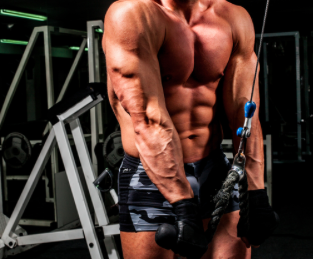Occlusion Training: Lift Light to Mass Up
In matters physiological, the process of occlusion has largely negative connotations. Occlusion, meaning to shut off or obstruct, of a ...

In matters physiological, the process of occlusion has largely negative connotations. Occlusion, meaning to shut off or obstruct, of a ...
Question: “Let’s say we have your average trainee who works out four of five times a week, working each bodypart ...
Imagine an image such as this…. You are in your car heading to the gym to train today. You have ...
There is, without a doubt, a no more difficult area of the body to develop muscle size and strength, than ...
What you need to know in review: Carbs have a direct effect on the release of insulin Insulin is considered ...
Omega-3s are one of the fats that actually have gotten a lot of good press. In this case it’s actually ...
The first thing to discuss here is what it really is to lose 10lbs of pure fat. Most people lose ...
Could the numerous benefits of this often overlooked amino contain the key to unlocking your gains? From growth hormone stimulation ...
When is rest for the wicked but a necessity for gains? We let the science do the talking...
The problem with body fat is that when you start to accumulate it in large quantities (more than 20lbs), it ...
Worried about overtraining? MI40 Top Gun Bryce Bahm is here with some simple steps you can take to byass the ...
Training arms is so important to the common bodybuilder or fitness enthusiast that there is absolutely no shortage of information ...
Question:
“Let’s say we have your average trainee who works out four of five times a week, working each bodypart twice per week, and is trying to decide if they should aim for ‘intensity’ or ‘volume’… what’s going to get them the best bang for their buck?”
This all depends on your level of experience, the more advanced you are. When we say ‘intensity’, we’re referring to the amount of weight lifted, Dorian Yates-style Blood and Guts training. A guy like Dorian Yates is extremely mesomorphic and extremely advanced… he is able to achieve a tremendous muscular contraction with every single rep. The time you’ve been training, you’re training age, is correlated with your body’s ability, and your nervous system’s ability, to contract muscle.
The average human contracts between 25% and 30% of their muscles’ fibers per contraction. The average sprinter, or the average professional bodybuilder, they contract up to 60%. I think it’s been as high as 68% or even 70% for some people. So,  their ability to contract muscle is greater. Obviously they’re going to fatigue their body faster, and also get a greater training effect from less overall volume.
their ability to contract muscle is greater. Obviously they’re going to fatigue their body faster, and also get a greater training effect from less overall volume.
Where someone is a beginner, they simply need to do more to get the same effect because they’re just not contracting as many muscle fibers.
So, for the average person, increased volume and increased frequency are the only real ways to build muscle, and that’s kind of the disconnect I think, a lot of the time. People think working a bodypart once a week is enough. And it’s really not for most people. I mean, doing a little less volume, and doing it a little more often, is going to be much more beneficial than doing 30 sets in one day. You could maybe do 17 sets twice a week, as opposed to one big, massive workout every seven days.
There is a limit in terms of the volume you can do. Obviously, initially, when you start out, you’re going to start with a lower frequency, lower volume training program. You can then, over time, increase the volume and frequency, but certainly not indefinitely to the point where you are doing a full-body split each day. You would train the body with less volume than that because of your greater ability to contract those muscles etc.
An advanced bodybuilder can get away with doing a bodypart once a week, because he or she is depleting that muscle so much. It may not be optimal though to train each just once a week, instead around every four to five days per week seems to be optimal for larger muscle-groups.
A bodybuilder like Dorian Yates could train his back once a week because there’s so much damage he could induce within the muscles that he probably needed five to six days to recover. The average person just isn’t doing that much work, even though it may be the same perceived effort, the amount of actual work being done within the muscle isn’t the same.
 If you can train more often and still recover, the more often you do it, the better. So it really comes down to trying to train as often as you possibly can. If I could train every muscle every single day, I would definitely be bigger than everybody else. The problem is, you can’t because your body won’t recover. So that’s one reason people start using anabolic steroids thinking, “maybe now I can hit everything two or three times a week with the same capacity each session instead of once”. And that’s where the increased growth comes from.
If you can train more often and still recover, the more often you do it, the better. So it really comes down to trying to train as often as you possibly can. If I could train every muscle every single day, I would definitely be bigger than everybody else. The problem is, you can’t because your body won’t recover. So that’s one reason people start using anabolic steroids thinking, “maybe now I can hit everything two or three times a week with the same capacity each session instead of once”. And that’s where the increased growth comes from.
Steroids allow you to recover faster so you can train more often, and train harder. It’s not actually necessarily from the fact that steroids build muscle. That’s really what the disconnect is, right? You can take steroids on their own and not gain an ounce of muscle unless your hormone profile is really out of whack. But if you’re an average man with a normal or optimal hormone profile, if you take steroids and don’t train, you won’t gain an ounce of muscle. Sure there may be some water retention, but you won’t gain muscle. It’s a matter of training harder and more often by increasing the frequency you train each muscle-group, thereby increasing efficiency in the nervous system.
If you were just starting out with a split, I’d probably alternate upper and lower because you still want to keep your time in the gym lower. For you to do an entire full-body split in a day, it would take you around three hours, even if you did just as few as four sets per body part. So I’d probably split it so that I was spending an hour to an hour-and-15 in the gym, maybe up to an hour-and-a-half which I think should be maximum, and getting in a fair amount of volume per body part every other day. To really do a sufficient workout for each body part, it would just take too long.